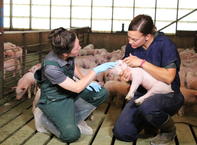
Mange
Mange is probably the most common skin problem in pigs and is responsible for considerable financial losses through effects of the parasite’s life cycle. Mange is caused by small mites (Sarcoptes suum) that live in the skin of the pigs. They are extremely small, so a sample needs to be taken to identify them under a microscope.
The mites feed on the skin, blood and serum of the pigs and lay their eggs inside the skin of the pigs. The fertilised female lays eggs in a tunnel inside the skin where insecticides can’t reach. Intense itching accompanies the immature parasite migrating until it reaches maturity when fertilisation occurs and the cycle starts again.
According to Danie Visser’s Modern Pig Production manual, this severe itching, with pigs rubbing against objects in search of relief, is usually the first sign that something is wrong. Sores, crusts and bare patches will appear as the condition progresses, usually first on the inside of the ear and gradually extending to the rest of the body.
The coat of the pigs will also look dull and lines will form on the body that look like ribs. Affected pigs will grow poorly, because they will be too busy scratching themselves to eat.
The condition may also lead to secondary infections and carcass condemnation at the abattoir.
Treatment Various dips, sprays and injections exist to kill the mites. The most effective treatment is an injection. The medicine is conveyed (via the bloodstream) to the immature parasites buried inside the skin as well as adult parasites on the skin. The alternative treatment is as a spray or immersion in insecticide solutions (read the label and directions of use carefully).
These dips or sprays must be repeated three times at weekly intervals and will treat the mature parasites as they emerged from the skin. Ask your veterinarian or animal health technician to recommend a product and help you develop a treatment programme to prevent future problems.
Treating adult pigs regularly will help to protect piglets. Never use old motor oil to treat mange. Besides this not being a cure for mange, motor oil will also cause skin damage.
Pig Louse
Pig louse (Haematopinus suis) live on the skin of pigs and are usually found on the skin folds around the neck, shoulders, groin and bellies of pigs. They do not affect humans or other animals.
Adult pig louse can grow up to 4 mm to 6 mm large, so are easy to identify by the naked eye, along with masses of eggs that look like a yellow crust. They are blood suckers, causing severe irritation that may lead to affected pigs rubbing on walls or feeding troughs in search of relief.
As with mange, this may have a negative impact on feeding, resulting in poor growth, and may cause secondary infections and carcass condemnations. Large numbers may also lead to anaemia.
Treatment Various registered dips and sprays exist to kill these lice. Ask your veterinarian or animal health technician to recommend a product and treatment programme. Please note: Information is for educational and informational purposes only and may not be construed as medical advice. The information is not intended to replace medical advice or treatment offered by your veterinarian.
By Glenneis Kriel